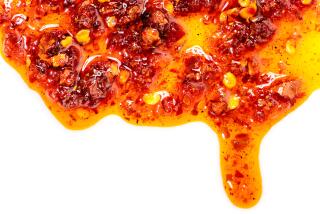The Peak of Hotness
- Share via
Capsaicin--or rather, the seven related chemicals known as capsaicinoids--are what make chiles hot, and once the pods are picked, the chemicals are pretty stable. Dried chiles found in South American tombs thousands of years old are still peppery.
However, the chile plant that produces capsaicinoids also starts destroying them at a certain point. In the May 20 Web edition of the Journal of Agricultural and Food Chemistry, published by the American Chemical Society, two scientists at the Universidad Autonoma de Queretaro, Mexico, reported a study of the level of hot stuff in chiles at various ages of the plant. They found that there’s a peak, after which the level falls rapidly, due to compounds called peroxidases, which occur naturally in the living plants. In pequin chiles, reported Elhadi M. Yahia and Margarita Conteras-Padilla, the peak is 40 days; in habaneros (which have a long way to coast, of course), it’s 50.
“If we can understand how capsaicinoids break down,” commented Yahia, “this could be a first step in reducing these losses for those cultures where chile peppers are of great importance.”
Objective Chiles
Every hot sauce claims astronomical “Scoville units,” referring to an old-fashioned and somewhat subjective system of evaluating chile hotness. Now the hot sauce catalog company Mo Hotta Mo Betta is taking the issue out of the speculative realm. It has submitted all its hot sauces to a laboratory for High Performance Liquid Chromatography analysis.
The lab used by the San Luis Obispo-based mail order company rates Tabasco at 2,140 Scoville units, El Yucateco Habanero (green) at 8,910, Dave’s Insanity Sauce at 51,000 and the infamous Mad Dog Inferno at 89,560. A dry mixture of ground peppers comes in at 180,000, which must be pretty close to the natural limit.
True chile loons will just have to try Mad Dog Inferno and its like. But, for the record, the numerical ratings are accompanied in Mo Hotta Mo Betta’s catalog by a “thermometer” scale, which doesn’t bother to distinguish among levels over 5,000 units. Above that level, hotness is not so much culinary as, let’s say, recreational.
The Chocolate Panic
The chocolate-eating world was rocked May 4 by a New York Times story that raised the specter of a global chocolate shortage due to disease and insect problems in the cacao plantations. Researchers were said to be predicting a shortfall in as few as five years.
Since then, the Chocolate Manufacturers Assn. has issued a reassuring reply, which sounded as if it feared a run on the chocolate stores and an orgy of chocolate hoarding. “We’re in no danger of running out of chocolate,” said CMA Vice President for Public Affairs Susan Smith. The chocolate industry is looking at raising cacao trees on smaller plantations, where the trees will be less subject to pests.
An Olive Oil Gusher
Last year was a boom year for olive oil--American imports spurted up 45% over the preceding year. OK, so 1996 was actually a slow year, when imports declined 10% from two years earlier, but 1997 still saw about a 30% jump from 1994’s high. Altogether, American olive oil imports have grown 500% since the early ‘80s.
Today’s Steak News
A.1. Sauce has a hotline that provides steak-cooking pointers from big-time steak chefs, such as Tony Tammero of the Palm Steak House in Washington, D.C. The easily memorizable number is (888) A1-STEAK.
At the same number, you can also get information about the Rolling Steak House, a trailer truck converted into a mobile steak kitchen, which will serve 16 tons of steak (marinated with 10,000 quarts of you-know-what sauce) in 44 cities around the country this summer.
More to Read
Sign up for Essential California
The most important California stories and recommendations in your inbox every morning.
You may occasionally receive promotional content from the Los Angeles Times.













